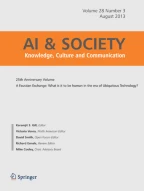Abstract
Digital technologies are frequently considered as lacking material aspects. Today, it is evident that behind digital technologies lies a huge and complex material infrastructure in the form of fiber optic cables, servers, satellites, and screens. Postphenomenology has theorized the relations to material things as embodiment relations. Taking into account that technologies can also have hermeneutic aspects, this theory defines hermeneutic relations as those in which we read the world through technologies. The article opens with a review of some theoretical developments to hermeneutic relations with a special focus on digital technologies. The article suggests that in the digital world, material hermeneutics needs to be updated as it shifts from a scientific to an everyday technological context. Now, technologies not only “give voice” to things, they also produce new meanings to informational structures and direct users to certain meanings. When it comes to digital technologies, especially those involving artificial intelligence (AI), the technology actively mediates the world. In postphenomenological terms, it possesses a technological intentionality. The postphenomenological formula should be updated to reflect this type of technological intentionality, by reversing the arrow of intentionality so that it points to the user, rather than from the user.
Similar content being viewed by others
Explore related subjects
Discover the latest articles, news and stories from top researchers in related subjects.References
Buongiorno F (2019) Embodiment, disembodiment and re-embodiment in the construction of the digitial self. Humana Mente J Philos Stud 36:310–330
Derrida, 1976 Of grammatology (Gayatri Chakravorty Spivak). Johns Hopkins University, Baltimore
Hayles NK (1999) How we became posthuman: virtual bodies in cybernetics, literature, and informatics. The University of Chicago Press, Chicago
Hayles NK (2017) Unthought: the power of the cognitive nonconscious. University of Chicago Press, Chicago
Heelan PA (1991) Hermeneutical phenomenology and the philosophy of science. Gadamer and hermeneutics: science, culture, and literature, by Hugh Silverman. Routledge, New York, pp 213–228
Ihde D (1990) Technology and the lifeworld: from garden to Earth. Indiana University Press, Bloomington and Indiana
Ihde D (1998) Expanding hermeneutics: visualism in science. Northwestern University Press, Evanston
Ihde D (2009) Postphenomenology and technoscience: The Peking University Lectures. State University of New York Press, New York
Ihde D (2015) Preface: positioning postphenomenology. postphenomenological investigations: essays on human-technology relations, by Robert Rosenberger, & Peter-Paul Verbeek. Lexington Books, Lanham, pp vii–xvi
Just N, Latzer M (2017) Governance by algorithms: Reality construction by algorithmic selection on the Internet. Media Cult Soc 39(2):238–258
Latour B (2005) Reassembling the social: an introduction to Actor-Network Theory. Oxford University Press, Oxford
Latour B (2011) Networks, societies, spheres: reflections of an Actor-Network Theorist. Int J Commun 5:796–810
Liberati N (2016) Augmented reality and ubiquitous computing: the hidden potentialities of augmented reality. AI Soc 31(1):17–28. https://doi.org/10.1007/s00146-014-0543-x
Manovich L (2013) Software takes command. Bloomsbury Academics, London and New York
Rosenberger R, Verbeek PP (2015) A field guide to postphenomenology. In: Rosenberger R, Verbeek PP (eds) Postphenomenological investigations: essays on human-technology relations. Lexington Books, Lamham, pp 9–41
Tripathi AK (2016) Culture of sedimentation in the human–technology interaction. AI Soc 31(2):233–242. https://doi.org/10.1007/s00146-015-0581-z
Tripathi AK (2018) Technological mediation and sociocultural variability. In: Aagaard, Friis, Sorensen, Tafdrup and Hasse (Eds) Postphenomenological methodologies: new ways in mediating techno-human relationships. Lexington Books, Lanham, pp 217–239
Verbeek PP (2005) What things do: philosophical reflections on technology, agency and design. The Pennsylvania State University Press, University Park
Verbeek PP (2008) Cyborg intentionality: rethinking the phenomenology of human–technology relations. Phenomenol Cognit Sci 7:387–395. https://doi.org/10.1007/s11097-008-9099-x
Wellner G (2015) A postphenomenological inquiry of cell phones: genealogies, meanings, and becoming. Lexington Books, Lanham
Wellner G (2017) I-media-world: the algorithmic shift from hermeneutic relations to writing relations. Postphenomenology and media: essays on human–media–world relations, by Yoni Van den Eede, Stacey Irwin, & Galit Wellner. Lexington Books, Lanham, pp 207–228
Wellner G (2018) “From cellphones to machine learning. a shift in the role of the user in algorithmic writing.” in towards a philosophy of digital media, by Alberto Romele, & Enrico Terrone. Palgrave MacMillan, Cham pp 205–224
Wiener N (1948) Cybernetics: Or control and communication in the animal and the machine. Technology Press and John Wiley, Cambridge and New York
Wiltse H (2014) Unpacking Digital Material Mediation. Techné Res Philos Technol 18(3):154–182
Author information
Authors and Affiliations
Corresponding author
Additional information
Publisher's Note
Springer Nature remains neutral with regard to jurisdictional claims in published maps and institutional affiliations.
Rights and permissions
About this article
Cite this article
Wellner, G. Material hermeneutic of digital technologies in the age of AI. AI & Soc 38, 2159–2166 (2023). https://doi.org/10.1007/s00146-020-00952-w
Received:
Accepted:
Published:
Issue Date:
DOI: https://doi.org/10.1007/s00146-020-00952-w
